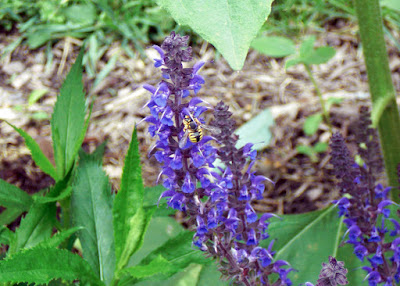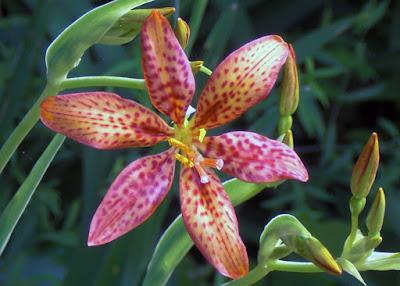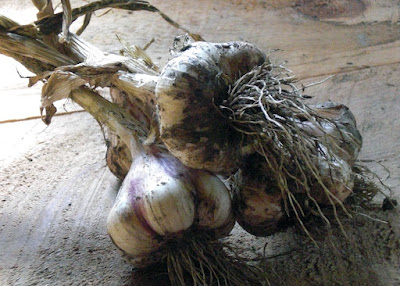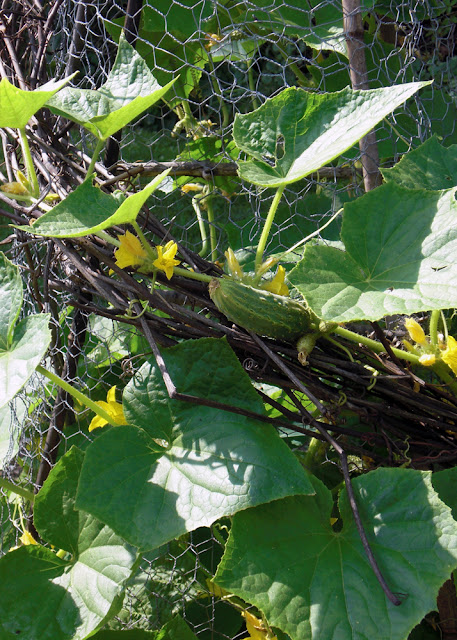The month of June in my North American Native Bee Calendar purchased from the Great Sunflower Project, features the Wool Carder Bee, genus Anthidium. These bees emerge in summer and will nest in nesting blocks, preformed cavities in wood or hollow plant stems.
They are about 1/2-3/4 inches long depending on the species. Both the males and females have a black or brown abdomen with varying patterns of striking yellow or white markings.
The males are extremely territorial and will patrol a patch of preferred flowers jealously guarding it for potential female mates. They are easily recognized by their hovering, darting and ramming maneuvers. When other males or bees of another species attempt to land on the flower that's being guarded, the Anthidium male will hover for a moment near the trespasser and then forcefully bump him off.
I believe I've seen this in action and have several of these bees patrolling my sage, lamb's ear, and lemon balm. They truly do hover, dart and ram. This one I captured guarding my sage:
Wool Carder Bees are especially attracted to sage, lavendar, catnip and trefoil.
Friday, July 30, 2010
Tuesday, July 27, 2010
Whoops-a-Lily?
I say this every time I make an "oops," even though the saying is 'whoops-a-daisy.' Reason being one day at work (previous job), a friend and I decided we would substitute different flowers for the daisy each time we made a typographical error during catalog production. We would shout out "whoops-a-lily" (which stuck in my brain), or "whoops-a-petunia" or "whoops-a-pansy" ... The earlier terms 'upsy-daisy,' 'upaday,' etc., appear to be the source of the term whoops-a-daisy although they have different meanings. The 'daisy' part is a fanciful extension of the word day. The name daisy itself derives from the word day. The daisy flower, which closes at night and exposes its yellow center in sunlight, was thought of as the day's eye. Upsy-daisy and derivatives were exclaimed when a child, in play, was assisted in a spring-leap from the ground (up from the daisies). The expression 'Whoopsie Daisy!', is first recorded in the New Yorker, in September 1925 and means to publicly acknowledge a mistake. It is now also exclaimed whoops-a-daisy, or whoops or oops. That's a lot of whooping.
Whoops-a-lily!
Whoops-a-lily!
Whoops-a-lily!
Whoops-a-Mojo!? How did he get in there? Oops.
Whoops-a-asiatic lily!
We're really whooping it up now!
Whoops-a-crocosmia! Which is not a lily but is in the same family, Iridaceae, as ...
... the Blackberry Lily - which is not a lily at all!
Whoops-a-crazy-daisy!
Anyway, these are all blooming in my garden right now and I have fun walking around "whoopsinging" all the day long.
Whoops-a-lily!
Whoops-a-lily!
Whoops-a-lily!
Whoops-a-Mojo!? How did he get in there? Oops.
Whoops-a-asiatic lily!
We're really whooping it up now!
Whoops-a-crocosmia! Which is not a lily but is in the same family, Iridaceae, as ...
... the Blackberry Lily - which is not a lily at all!
Whoops-a-crazy-daisy!
Anyway, these are all blooming in my garden right now and I have fun walking around "whoopsinging" all the day long.
Tuesday, July 20, 2010
What's Growing
I just harvested my first ever garlic crop! I have it drying in my shed for about two weeks. In its place I've planted parsnip seeds.
Soft garlic harvest.
Hardneck garlic harvest.
I also just pulled my spinach which began to flower and will plant some more. I had to capture this rainbow of swiss chard - var. Multicolor Bright Lights - before I planted again. (Don't mind the stalks that I've already munched! My favorite so far? Swiss chard sauteed in olive oil with garlic and bacon over pasta topped with a good grate of parm cheese.)
Cabbage head - Ruby Perfection.
Baby brussels.
Bean blossoms and beans! (Purple Royal Burgundy.)
It's beans and butter for dinner!
Climbing cukes, Northern Pickling Cucumbers.
Sweeties! And sweet they are ... yum!
Soft garlic harvest.
Hardneck garlic harvest.
I also just pulled my spinach which began to flower and will plant some more. I had to capture this rainbow of swiss chard - var. Multicolor Bright Lights - before I planted again. (Don't mind the stalks that I've already munched! My favorite so far? Swiss chard sauteed in olive oil with garlic and bacon over pasta topped with a good grate of parm cheese.)
Cabbage head - Ruby Perfection.
Baby brussels.
Bean blossoms and beans! (Purple Royal Burgundy.)
It's beans and butter for dinner!
Climbing cukes, Northern Pickling Cucumbers.
Sweeties! And sweet they are ... yum!
Sunday, July 18, 2010
What's Blooming: Island Meadow
For two years my family has come together to rent a cabin on one of the islands on the St. Lawrence River. I am still on "river time" so this bloom day is a little late. The cabin we rent is on acres of land and on top of the spectacular river view in the front, boasts a large, beautiful meadow in the back. Here is the driveway, a good two hours walk to the cabin, as viewed from the only road on the island.
The wind rustles the grass and wild flowers. The wind shapes the trees.
The Milkweed is in bloom and the fields flutter with Monarchs.
A wild beast - Mojo, a Goldendoodle - seeks shade.
The perfect place to get away from it all. The perfect place to make a wish - may we all return again next year.
Bloom Day is hosted by Carol at May Dreams Gardens the 15th of each month. Visit Carol's blog and add your blog to the list so we can see what's blooming by you!
The wind rustles the grass and wild flowers. The wind shapes the trees.
The Milkweed is in bloom and the fields flutter with Monarchs.
A wild beast - Mojo, a Goldendoodle - seeks shade.
The perfect place to get away from it all. The perfect place to make a wish - may we all return again next year.
Bloom Day is hosted by Carol at May Dreams Gardens the 15th of each month. Visit Carol's blog and add your blog to the list so we can see what's blooming by you!
Tuesday, July 6, 2010
Project: Hypertufa Trough
This year I have been attempting to make homemade gifts. I feel that with today's onslaught of retail, the art of giving and truly celebrating has been lost. There are many "projects" on my mental list of things to try, and the outcome can make for a great gift. One of the projects I can now check off my list, is a hypertufa trough - though I had so much fun, I plan to make more!
I used this recipe to make the hypertufa mix:
1 part Portland cement
1 part perlite
2 parts peat moss
I had to buy a HUGE bag of Portland cement which was difficult as it is very heavy - so bring some muscle, but your local store may stock smaller bags. On the other hand, I have plenty on hand now whenever the hypertufa mood strikes.
I used an old yogurt container to measure my mix. i.e. one scoop cement, one scoop perlite, two scoops peat moss. Fortunately for me (and maybe you, too), it's not an exact measurement, just a ratio. Too much math or measuring and I would not be inclined to try this project.
I added enough water to the mix to make a thick mud. I added the water slowly with my sprinkling can - too much water and you will need more mix. I compare it to making a good baking dough - it's easier to add water/milk than more flour, etc. If you can grab a handful, make a snowball (retain shape), and squeeze out only a few drops of water - perfect!
I started out small (the mix will not keep once it is moist) but soon moved on to a bigger batch of mix. I ended up using my favorite garden tub from Gardner's supply - cleaned up very easily. I also wore an old bandana over my nose and mouth when mixing the dry ingredients to prevent breathing in the dust. I also wore gloves. By the way, I would not recommend making this project at your kitchen table.
The mix will not stick to cardboard, plastic or Styrofoam. I used three sets of cardboard boxes that I collected over time - a smaller inside a larger, to make three troughs. I used small sections of sticks in the bottom of each to create drainage holes. I had some chicken wire leftover from wrapping my young trees last winter, so I cut it into small sections and used it as reinforcement. You could also add a handful of synthetic concrete reinforcing fibers. I think I may use those in my future hypertufa projects - the chicken wire was a little awkward to work with.
Once I had my molds packed firmly, I placed them inside plastic garbage bags in the shade to cure for the first 24 hours. You should then remove them from the molds and set them in a semi-shady spot to cure for another three weeks before planting.
Two of the troughs I gave to my mother for Mother's Day along with some moola for buying plants. The best part of this gift was spending the day with my mom. We went to a fantastic local greenhouse known for carrying a large alpine and sedum plant selection and had much fun picking out plants for the troughs. Here are hers planted up.
I am going to plant the one trough I kept for myself with some mosses and miniature woodland plants for a focal spot in my new woodland edge border. The troughs should develop a nice patina over time. Because this project worked and was fun, I hope to experiment with more molds. Maybe try a couple of round planters by inverting a round pot or mounding up dirt. Also, I would like to try adding some leaf impressions or river stones while the mix is still wet - there are so many possibilities!
I used this recipe to make the hypertufa mix:
1 part Portland cement
1 part perlite
2 parts peat moss
I had to buy a HUGE bag of Portland cement which was difficult as it is very heavy - so bring some muscle, but your local store may stock smaller bags. On the other hand, I have plenty on hand now whenever the hypertufa mood strikes.
I used an old yogurt container to measure my mix. i.e. one scoop cement, one scoop perlite, two scoops peat moss. Fortunately for me (and maybe you, too), it's not an exact measurement, just a ratio. Too much math or measuring and I would not be inclined to try this project.
I added enough water to the mix to make a thick mud. I added the water slowly with my sprinkling can - too much water and you will need more mix. I compare it to making a good baking dough - it's easier to add water/milk than more flour, etc. If you can grab a handful, make a snowball (retain shape), and squeeze out only a few drops of water - perfect!
I started out small (the mix will not keep once it is moist) but soon moved on to a bigger batch of mix. I ended up using my favorite garden tub from Gardner's supply - cleaned up very easily. I also wore an old bandana over my nose and mouth when mixing the dry ingredients to prevent breathing in the dust. I also wore gloves. By the way, I would not recommend making this project at your kitchen table.
The mix will not stick to cardboard, plastic or Styrofoam. I used three sets of cardboard boxes that I collected over time - a smaller inside a larger, to make three troughs. I used small sections of sticks in the bottom of each to create drainage holes. I had some chicken wire leftover from wrapping my young trees last winter, so I cut it into small sections and used it as reinforcement. You could also add a handful of synthetic concrete reinforcing fibers. I think I may use those in my future hypertufa projects - the chicken wire was a little awkward to work with.
Once I had my molds packed firmly, I placed them inside plastic garbage bags in the shade to cure for the first 24 hours. You should then remove them from the molds and set them in a semi-shady spot to cure for another three weeks before planting.
Two of the troughs I gave to my mother for Mother's Day along with some moola for buying plants. The best part of this gift was spending the day with my mom. We went to a fantastic local greenhouse known for carrying a large alpine and sedum plant selection and had much fun picking out plants for the troughs. Here are hers planted up.
I am going to plant the one trough I kept for myself with some mosses and miniature woodland plants for a focal spot in my new woodland edge border. The troughs should develop a nice patina over time. Because this project worked and was fun, I hope to experiment with more molds. Maybe try a couple of round planters by inverting a round pot or mounding up dirt. Also, I would like to try adding some leaf impressions or river stones while the mix is still wet - there are so many possibilities!
Subscribe to:
Comments (Atom)

































